By Donald H. Harrison

ANGELUS OAKS, California—Along with a few other San Diegans, I visited Camp Mountain Chai in the San Bernardino Mountains last week. On arrival, I saw a Baer.
It turned out that Dan Baer is the director of the camp, located 134 miles from the parking lot of the Jewish Federation of San Diego, one of the organizations that helped bring this pluralistic Jewish camp into existence 13 years ago. This is the camp’s bar mitzvah year.
Baer, along with the camp’s executive director Buddy Voit, provided a tour of the camp to a group that included Rabbi Avi Libman of Congregation Beth El; Libman’s associate, Jessie Blank-Birnbaum, Beth El’s associate director for education and youth; L’Chaim Magazine publisher Diane Benaroya; and this writer.
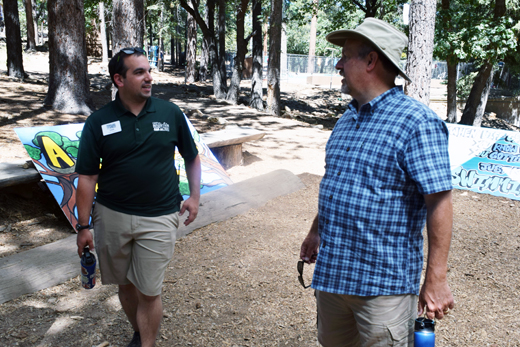
It is a maxim in the Jewish world that attendance at an overnight Jewish camp is one of the surest ways to make an enthusiastic connection between a youth and his/ her Judaism. Enthusiasm was very much in evidence as we witnessed a singing, chanting gathering of the campers around the American and Israeli flagpoles, and later joined nearly 200 campers for a kosher lunch of turkey nuggets, beans n’ franks, and broccoli. Songs, chants, competitions, impromptu dancing, and an exuberant table-pounding, hand-waving after-meal Birkat Hamazon prayer, were the ambiance for the meal.
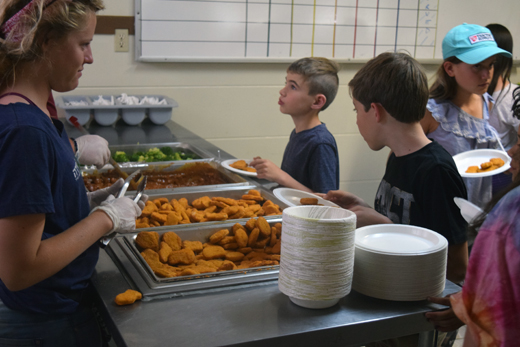
The camp is located on U.S. Forest Service land at an altitude of 7,400 feet. If one looks to the north, the view is of the back side of Big Bear Mountain. The ski slopes are on the other side of the mountain. The first three buildings of the camp, including its office, were World War II surplus buildings which were disassembled, carted up the mountain, and then reassembled. The many other buildings including the bunk houses where 10-15 campers stay with a minimum of two, and sometimes three, counselors were constructed over the following decades. Before this campground became known as Mountain Chai—in a naming contest sponsored by the late Murray Galinson and his wife Elaine—it had housed several other camps, including a Boy Scout camp and a YMCA camp.
According to Baer, Mountain Chai has a special niche in the world of Jewish camping. It is pluralistic, accommodating all streams of Judaism. Most of its campers come from San Diego County. Additionally, Camp Mountain Chai is international, drawing Jewish cabin counselors and Jewish and non-Jewish activities specialists from as far away as New Zealand, as well as from Israel, and various countries in the Americas and Europe.
Explaining what he meant by “pluralistic,” Baer noted that Orthodox Jews observe the prohibition against cutting or creating on Shabbat, so for Orthodox campers such activities as arts and crafts are not permissable on a Saturday. Yet, Reform and Conservative Jews, who together make up a large majority of the camp’s attendees, are not restricted by such a prohibition. So, what is the solution? Any activity that is done on Shabbat also is scheduled on another day of the week, so that Orthodox campers may take advantage of them, should they so desire.
“Almost two-third of our kids are from San Diego County, and their parents love that the children’s friends will also be coming here,” Baer said. “The cabin counselors are all Jewish, but the specialists often are not, and we want that cultural diversity. It is part of our culture to bring in new people and new voices.”
Having just returned from a cruise that spent considerable time in New Zealand, I was delighted to meet Georgia Catlow, the senior lifeguard from Christchurch who, along with other lifeguards, keeps watch over the children not only at the camp’s swimming pool, but also as they go boating on Jenks Lake. Voit said that lake has both a private and public area, and the campers are entitled to use the private area in the morning, before the rush. The campers typically board buses for their boating experiences by 7:30 in the morning, returning in plenty of time for lunch and afternoon activities.
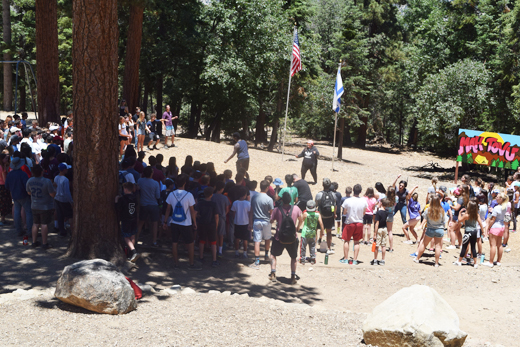
I asked Baer what the typical schedule for the camp is. “We meet at the flagpoles at 8 a.m., we stand in a circle and we sing a couple of songs, including Ma Tovu, do cheers, go to breakfast, have cabin clean up after breakfast, and then have three morning activities of 50 minutes each, and two more activities in the afternoon,” he responded. “After dinner, we have an evening program from 7:30 p.m. to 8:30 p.m., and depending on how old the kids are, they start going to bed at 8:30 p.m.”
Hillary, a 14-year-old camper from La Jolla, and Ryan, a 13-year-old from Encinitas, further elucidated.
“We gather in circles with our cabins at the two flag poles, say a prayer before the meal, do cheers”—there’s one for each cabin—”and the leader decides who has the best cheer and sends them into the dining hall in that order,” Ryan commented.
“Everything is motivated here by ruach and spirit,” said Hillary. “We are very into cheering and all of that. Even during meal times, the units battle it out to see who has the most spirit!”
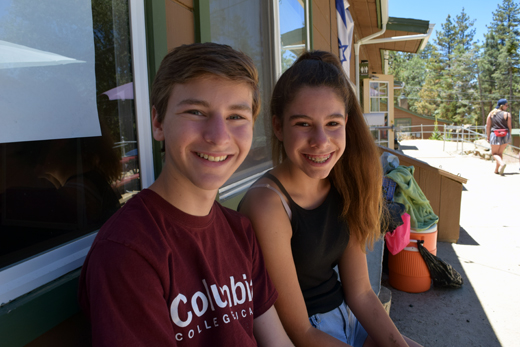
Hillary, whose family are members of Congregation Beth Israel, has been coming to Mountain Chai for multiple sessions over five summers. This is the tenth year for Ryan, who started going to camp when he was three years old. (Today, pupils about to enter the second grade are the youngest campers.) It is no surprise that both Hillary and Ryan speak with authority about the camp and its activities.
Why do they keep coming back? “It’s really the experience, the staffers, and the kids too,” said Ryan. Although some people complete their camping every year, “there are always returning people who are just so wonderful to be around,” he said.
Hillary commented that for her, “it is the community. It is really special to me because I am not super connected to Judaism when I am at home, but when I am here, there are a lot more opportunities to be a bit more spiritual.” And, “it is gorgeous. Look at the view!”
Ryan and Hillary will be entering the eighth and ninth grade respectively when school resumes. Both said they are looking forward to the summer before the eleventh grade when they will be eligible for a special “Kavanah” program in which the oldest campers go on a three-week trip to the Dominican Republic where they live in the towns of Cabarete and Sosua and help teach English, lead children in games, repaint playgrounds, and help to clean up a Jewish cemetery dating back to the time the Dominican Republic welcomed Jewish refugees escaping Hitler’s Europe. The participants also visit Santo Domingo to learn about the Dominican capital, and to enjoy a traditional Shabbat meal with the Chabad representatives there.
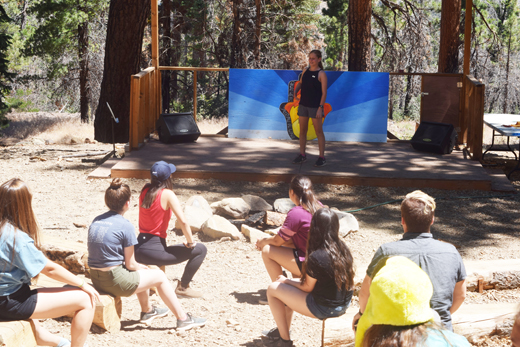
Back here at Camp Mountain Chai, there are more than 20 activities that occupy the campers’ attention over the course of a week. While on tour, we saw campers engaged in arts and crafts, ceramics, swimming, rope climbing, soccer, and acting, and also passed by a horseshoe pit, a gaga pit, and numerous signboards the campers had learned to paint graffiti style. “Gaga” is an Israeli version of dodge ball in which participants are only “out” if they are hit by a ball below their knees.
In the acting activity that we witnessed, campers were asked to go up on an outdoor stage and declaim, from Shakespeare’s Hamlet, “To Be, or Not To Be, That is the Question.” Campers in the back row of the amphitheater were asked to raise their hands if they could hear the lines. If they couldn’t, it was time for the camper to do it again – only louder!
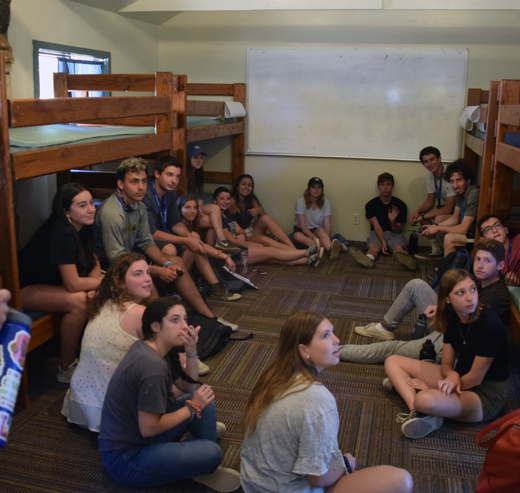
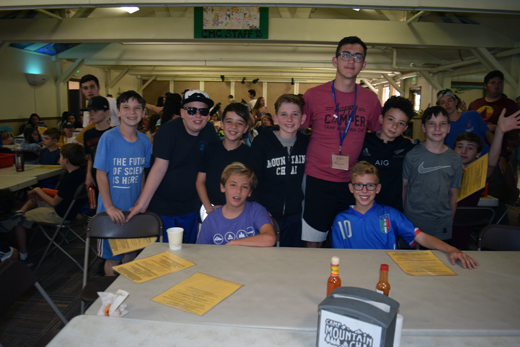
Our tour came on the second day of the second session of the camp. The first session lasted two weeks. This session will last three weeks. And the next and final session will last two weeks. More older campers tend to attend the longer middle session than the shorter two sessions. During the first session, Staff-In-Training discussed theories of being counselors and had some practical experiences. This second session, they actually were assigned to cabins as assistant counselors. Staff-in-Training are known as SITs for short. One of them is San Diegan Blake Dujowich, who was assigned to a cabin with 10 boys who will go into the seventh grade after summer vacation. At lunch, his cabin won the spirit award for their enthusiastic chanting. All the boys in the cabin have been to the camp in previous summers.
Blake told me that during the training session, he learned from senior counselors, their supervisors, and from the camp assistant director and director various strategies for dealing with situations that may come up during the session. For example, he told me that homesickness among young, first-time campers may become an issue. “So, we try to help them persevere through the home sickness. For example, I would try to understand why they are homesick. Do they miss their moms? Or perhaps their dog? I would try to find what they are missing and then try to help. If it’s the dog, we could have the parents send a photo of the dog. If it’s the parents, we could ask the parents to write a letter. If it’s general homesickness –‘That has always been my home, my living space, and this isn’t my home’ – we try to encourage them to go out and have fun if they can, and they get over it.”
Counselor Lauren Kaplan Matlow told me of one youngster who kept saying he didn’t want to be at the camp. Then he went out on the archery range, and after shooting some arrows, announced, “You know, I really want to stay.”
Baer said that if the homesickness problem becomes acute, there is a social worker who can meet with the unhappy child to learn what the trouble is. Because the camp makes a point of hiring additional counselors who are floaters—able to step into any situation in case another counselor has to leave the camp, or if a special need arises – there also is the possibility of assigning one of these floaters to the troubled camper. As a very last resort, which will happen very few times during an entire summer, arrangements can be made for the child to return home.
Camp Mountain Chai has a health center, staffed with a doctor and two nurses, who sometimes trade their time and talents for the opportunity to be with their families at camp, Voit said.
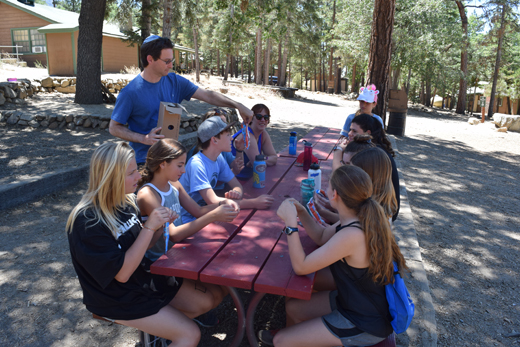
The day we toured the camp, Rabbi Jeremy Gimble of Congregation Beth Israel arrived to be on hand as a Judaic resource. The camp likes to schedule San Diego rabbis on working visits to the camp to provide the campers with a sense of the connection between the synagogue world and the camping world. As Rabbi Avi Libman of Congregation Beth El was also touring the camp, arrangements were made after lunch for him to have a brief meeting with all the campers who were members of his congregation. It was a happy, informal affair.
Another professional at the camp is Marshall Voit, who is the cantorial soloist at Temple Emanu-El and is the son of the camp’s executive director Buddy Voit. Our tour group had the opportunity to see him in action during lunch time when he taught a Hebrew/ English song about “the whole world is a narrow bridge and the most important thing is not to be afraid.” He also runs an elective for campers and SITs “to train them in song-leading techniques to get them accustomed to do some leading.”
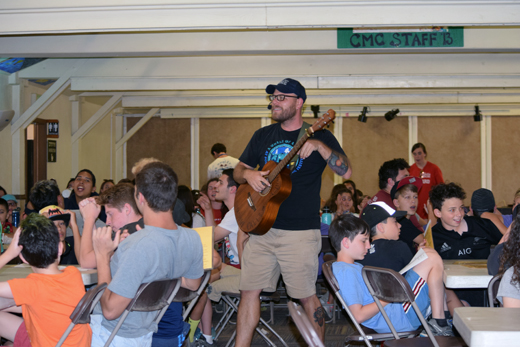
The cantorial soloist said to encourage kids to sign, “I often will stop singing myself – especially if it is a song they know – because then they can really hear themselves. I need a microphone to sing for 200 people. My voice is big, but not that big. If I stop singing, they have to create the sound themselves. Any time there are more than 20 or 30 kids, I say, ‘I’m just one person, you are 20 or 30, so all of you should be able to sing together louder than I am singing by myself. And for the kids that works—they feel kind of challenged—and they sing a little louder. The thing about song leading: it takes balance, because you are in the center of the room and are the center of attention, but the experience is not about you, it is about everyone else in the room. You are a facilitator, more than a performer, or a star.”
Marshall Voit added that he tries to introduce a song a week to add to the campers’ repertoire. They know or learn a lot of other songs during the camping session, and particularly enjoy those songs which involve hand motions, or call and response. “This group is easy to sing with,” he said. “They all sing enthusiastically.”
Over the 13 years of its existence, Camp Mountain Chai has developed some interesting traditions. Each week of camp, two campers per cabin who have shown the most spirit are awarded camp blankets. After meals, two songs are broadcast over the public-address system to accompany the campers as they clean up their tables. Dancing in the aisles—as campers did to a Spice Girls song on the day of our visit—is a symptom of youthful exuberance and enjoyment.
We completed our tour in the mid-afternoon, so we weren’t around for the evening. But judging by the high level of activity throughout the day, every camper must have slept very soundly.
Fees vary depending on the session, but director Baer told me that scholarships—or “camperships” as they are called in the trade—are available for families in need. The camp’s website is http://www.campmountainchai.com/
*
Harrison is editor of San Diego Jewish World. He may be contacted via donald. harrison@sdjewishworld.com
Thank you for the wonderful article on CMC. You were fortunate to see the camp in action and to observe the campers having fun while learning some Jewish rituals as well. I hope the San Diego community will continue to support this worthwhile project.
Thank you for this article. It brings back memories of my own summer camp experiences. Great piece and lucky kids!